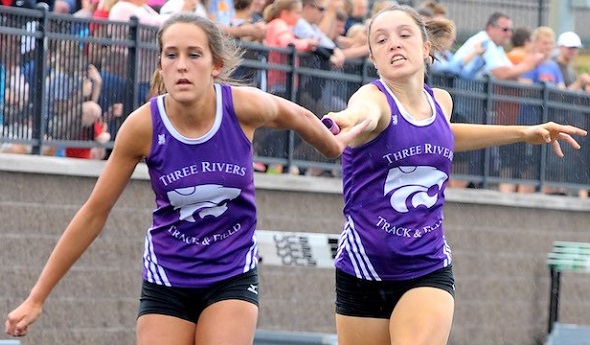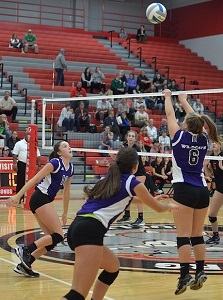
Busy Spring Next for Three Rivers 4-Sporter
By
Wes Morgan
Special for MHSAA.com
March 6, 2018
By Wes Morgan
Special for Second Half
For anyone complaining about not having enough hours in the day, meet Three Rivers sophomore Hadley Miller, whose productivity within a 24-hour span is nothing short of stunning.
 She’s one of those rare student-athletes who, as if there aren’t enough games to play, seemingly makes it a competition with herself to see how much she can pack into a given day.
She’s one of those rare student-athletes who, as if there aren’t enough games to play, seemingly makes it a competition with herself to see how much she can pack into a given day.
After completing varsity seasons with the Three Rivers volleyball and basketball teams, Miller will now start a spring regimen that begins at 4:30 a.m. each day and includes a taxing weight-room workout, a full day of school, track practice, soccer practice, homework, sustenance crammed in between, and then a few hours of sleep to recharge the battery.
 Miller is coming off an all-Wolverine Conference first-team performance in basketball after guiding the Wildcats to a 19-4 record this season, which ended in a Class B District Final loss to Edwardsburg last week.
Miller is coming off an all-Wolverine Conference first-team performance in basketball after guiding the Wildcats to a 19-4 record this season, which ended in a Class B District Final loss to Edwardsburg last week.
Miller averaged 18.6 points, 3.0 assists, 8.1 rebounds and 3.6 steals per game, leading the team in scoring for a second straight year. The Wildcats were 17-3 during the regular season and finished second to Edwardsburg in the Wolverine Conference South.
She’s one of the latest in a line of underclassmen at Three Rivers to emerge as a big-time playmaker, particularly at the guard/point guard positions. Teammate Kali Heivilin, a freshman, earned an all-conference second-team nod.
“I think it’s a combination of things,” Three Rivers girls basketball coach Jason Bingaman said. “Some is the system we play and our focus at the defensive end that can make the transition easier (for younger players). Specifically, from the individual though, (Miller’s) skill set, basketball IQ, and then how hard a player works has a lot to do with their performance, and I have been very fortunate to coach some players that are individually dedicated to basketball and have families that have invested time in their daughters’ development.”
Both Bingaman and Miller landed on team chemistry as the most important variable when it comes to youngsters integrating well at the varsity level.
“If upperclassmen understand how the younger player can help us be successful and are great teammates, it makes it an easier transition,” Bingaman explained. “Every player isn’t going to progress at the same rate, and each player is not brought up for the same reason as the next, but if the aforementioned things are in place, it makes it more likely for a player to be successful.”
 Miller’s humility and dedication to all four of her teams at Three Rivers is unquestioned, which makes the process of gaining respect from the upperclassmen that much easier. In terms of hoops, she said the team’s success really was a matter of player rapport after losing five seniors from 2016-17.
Miller’s humility and dedication to all four of her teams at Three Rivers is unquestioned, which makes the process of gaining respect from the upperclassmen that much easier. In terms of hoops, she said the team’s success really was a matter of player rapport after losing five seniors from 2016-17.
“We all clicked well,” Miller said. “Since we played a year together and know how we like to play, going into next year we are going to be even more confident.”
Bingaman said confidence is where Miller made a big leap from her freshman year to her sophomore campaign.
“The big thing in general is her confidence level and mental approach,” he said. “I believe she felt she could have an impact last year, but there was an adjustment period, and as she became more comfortable last season, we became better as a team. She has found out how to deal with teams being physical with her and being patient.
“This year I have thrown a lot at her in terms of what she is responsible for. I moved her from the wing to running our offense as the point guard over Christmas break due to injuries and she has run with it, all while increasing her minutes on the floor.”
Miller has proven she can do plenty in a matter of minutes with a mastery of time management. This month she transitions to soccer as a defender for the Wildcats, and to the track & field team, where she hopes to make a return trip to the Lower Peninsula Division 2 Finals. Miller was part of the 1,600-meter relay team with Stephanie McLochlin, Shelby Krawczak and Arionne Fowlkes that placed 17th overall in 2017.
Throw in club basketball in April and Miller will be constantly on the move well into the summer.
“I like to keep in shape and keep busy,” she said. “I really like to do sports. So why not? It all fits in there somewhere.”
 Wes Morgan has reported for the Kalamazoo Gazette, ESPN and ESPNChicago.com, 247Sports and Blue & Gold Illustrated over the last 12 years and is the publisher of JoeInsider.com. He can be reached at [email protected] with story ideas for Berrien, Cass, St. Joseph and Branch counties.
Wes Morgan has reported for the Kalamazoo Gazette, ESPN and ESPNChicago.com, 247Sports and Blue & Gold Illustrated over the last 12 years and is the publisher of JoeInsider.com. He can be reached at [email protected] with story ideas for Berrien, Cass, St. Joseph and Branch counties.
PHOTOS: (Top) Three Rivers' Hadley Miller, right, hands off the baton during a track relay last season. (Middle) Miller, far left, readies for a pass during a volleyball match at Vicksburg in the fall. (Photos courtesy of JoeInsider.com.)

Hastings Relays Reigns as State's Oldest Continuous Track & Field Meet
By
Steve Vedder
Special for MHSAA.com
April 10, 2024
Bob Branch remembers dabbling in other sports, but his first love was always running.
 The Hastings High School graduate admits he could never hit a baseball, football didn't especially appeal to him and basketball was just another way to spend time with friends. But for Branch, now 93, there was always track. That's the sport where his fondest and sharpest memories remain. And if you're talking track, many of his favorite memories come from participation in the state's oldest continuous track meet, the Hastings Relays.
The Hastings High School graduate admits he could never hit a baseball, football didn't especially appeal to him and basketball was just another way to spend time with friends. But for Branch, now 93, there was always track. That's the sport where his fondest and sharpest memories remain. And if you're talking track, many of his favorite memories come from participation in the state's oldest continuous track meet, the Hastings Relays.
Always held in early April, the meet dates back to 1937 – a bygone time that saw the first hostilities of World War II, gas at 20 cents a gallon and a loaf of bread selling for a dime.
And at a dusty old track surrounding the county fairgrounds in Hastings, a small relay event that included a scattering of participants from a dozen high schools was taking its first tentative steps.
Branch recalls a time when kids would run home after track practice because there were no buses, inexperienced young coaches had little actual knowledge of running fundamentals, and athletes looked at the sport as an afterthought after spending most of their high school days playing football and basketball.
 For Branch, the relays were the ideal way to ease into the track season.
For Branch, the relays were the ideal way to ease into the track season.
"I just liked to run," said Branch. "I remember I anchored a relay with my brother, and it always seemed cold when we had that meet. I remember teams would come from all over and you saw a lot of good athletes. Everybody seemed to have someone who was really good. Track wasn't very popular at that time, but I have a lot of good memories from running."
The Hastings Relays, which has changed formats and even names during its nearly nine-decade history, would traditionally kick off the track season. The meet was originally held at a makeshift quarter-mile track which surrounded the town's fairgrounds and was part of the city's annual Hastings Carnival – the track would become the midway during fair time.
The meet eventually moved to Johnson Field when the football field was dedicated in 1949 and ballooned to as many as 50 teams at its peak in 1957. For more than seven decades it was known as the Hastings Relays and then the Hastings Co-Ed relays before becoming the current Hastings Invitational, with the latest edition scheduled for Friday.
Johnson Field had a cinder track before it became an all-weather surface in the 1980s. During a time long before computers would be used to organize meet heats in mere minutes, Hastings coaches of all sports – defined as "volunteers" by the athletic department – would meet on the Friday before competition to hash out events.
People associated with the meet still recall the camaraderie built on those long Friday nights, followed by working what would often become 10-hour meets. Steve Hoke has been involved since watching his father, Jack, who coached teams at 15 of the meets beginning in 1951 and also had run in the first Hastings Relays. Steve Hoke later competed in the Relays as well during the early 1970s before becoming an assistant track coach, later the Hastings athletic director and now a volunteer worker.
"It was always a huge deal," said Hoke, who said the meet began as a pure relay event before transitioning to its current team format in the 1990s. "I remember we'd line the track the night before, and all the coaches would come to the house to organize everything. There was a brotherhood.”
 If you quiz many of the fleet of volunteers who've worked the relays over the years, each has a different memory from the meet. While Hoke describes the brotherhood and Branch the outstanding competition, others remember weather and the time a thunderstorm wiped out the line markings on the cinder track, or waking up to find three inches of snow that caused a rare cancellation of the meet. Others recall the shock of moving from the cinder to all-weather track or using the meet as an early measuring stick of what it would take to qualify for the state meet. The real old-timers remember the meet disappearing for three years during World War II.
If you quiz many of the fleet of volunteers who've worked the relays over the years, each has a different memory from the meet. While Hoke describes the brotherhood and Branch the outstanding competition, others remember weather and the time a thunderstorm wiped out the line markings on the cinder track, or waking up to find three inches of snow that caused a rare cancellation of the meet. Others recall the shock of moving from the cinder to all-weather track or using the meet as an early measuring stick of what it would take to qualify for the state meet. The real old-timers remember the meet disappearing for three years during World War II.
Hastings native and Western Michigan grad Tom Duits was the state’s second collegian to break the four-minute mile when he ran a 3:59.2 at a meet in Philadelphia in 1978. Duits, who ran in three Hastings Relays, was in line to join the U.S. Olympic team in 1980 before the United States pulled out of the games due to tension with Russia.
Duits has his own memories of the meet and the competition he faced there.
"I remember sunshine and being excited to be competing again. There were all these athletes swarming around; it was an awesome display of talent," he said. "It was always one of the best meets we'd be in. You could pretty much see the level of runners who would be at state, which made it a big deal. It was always early, but you could tell where you stood. It was great exposure."
Hastings track star Wayne Oom competed in four Hastings Relays from 1984-87. One of his sharpest memories was the difference between running on a raw cinder track versus the far more comfortable all-weather surface.
"Those cinders would grind into your skin," said Oom, part of the Hastings school record in the two-mile relay. "But I think it helped us because when we'd go to other tracks, it seemed we would run faster. I remember how competitive it was, especially in the distances. There were some great runners."
While participants have their unique memories, so do coaches. Former Saxons coach Paul Fulmer remembers 2008 when his team finished first on the boys side of the meet while his wife, Grand Haven coach Katie Kowalczyk-Fulmer, saw her girls team win the championship.
 "I knew we were one of the favorites to win because we were usually near the top of our conference and Regional," he said. "But then Katie's team was pretty good, and it was cool for them to win too."
"I knew we were one of the favorites to win because we were usually near the top of our conference and Regional," he said. "But then Katie's team was pretty good, and it was cool for them to win too."
Fulmer, who coached Hastings from 1978-81 and then 1985-2010, said at least part of the meet's popularity was derived from a unique way of scoring. Instead of individuals earning points solo, participants worked in pairs. For instance, two athletes would combine their shot put or long jump scores. New events such as the 1,500 relay and sprint medley were added.
"We had a tradition of being the state's oldest meet, and that was a big deal," Fulmer said. "And we ran a good relay; that attracted teams too. We took a lot of pride in that.
"And we'd get quite a lot of people to come to the meet. We'd set up until like 9 or 10 p.m., and then we'd have a party with all the coaches on Friday night."
While the meet has stretched 87 years, Branch said early participants and current runners have one thing in common: a drive to win. Branch ran in an era when the popularity of high school track was in its infancy. Today some of the best all-around athletes at a school are involved in the track program. The relays span the nearly nine decades in between.
"The quality of teams has gotten better and better," said Branch, the 1947 Lower Peninsula Class B Finals champ in the 220. "And this has made for a better meet. We would get guys who played football or baseball kind of drift into track, and that made the sport better. I think people began to appreciate track because we'd get teams from all over.
"We went from not really knowing what we were doing to track being a good sport. Even then, I'm not sure we appreciated what we had. We really liked the Hastings Relays and always wanted to do well there. It became popular and quite an honor to do well. Those are the kind of things I remember."
PHOTOS (Top) Racers run at the Hastings Relays, with several more awaiting their turns to compete at the longtime meet. (2) The author wrote on the 50th anniversary of the Relays for the Hastings Banner nearly 40 years ago. (3) Past athlete, coach and athletic director Steve Hoke shows some of the Relays awards from the 1930s. (4) Tom Duits was one of the state’s biggest track stars of the 1970s and ran in three Hastings Relays. (Top photo by Dan Goggins, Hoke photo provided by Steve Hoke and Duits photos provided by Tom Duits.)

